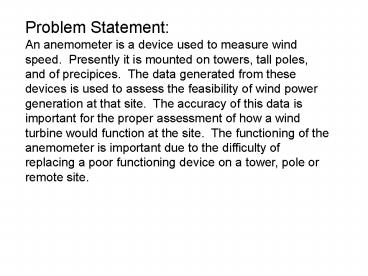Problem Statement: - PowerPoint PPT Presentation
1 / 11
Title:
Problem Statement:
Description:
The functioning of the anemometer is important due to the difficulty of ... A suitable anemometer will give information about both wind speed and pressure ... – PowerPoint PPT presentation
Number of Views:871
Avg rating:3.0/5.0
Title: Problem Statement:
1
Problem Statement An anemometer is a device
used to measure wind speed. Presently it is
mounted on towers, tall poles, and of precipices.
The data generated from these devices is used to
assess the feasibility of wind power generation
at that site. The accuracy of this data is
important for the proper assessment of how a wind
turbine would function at the site. The
functioning of the anemometer is important due to
the difficulty of replacing a poor functioning
device on a tower, pole or remote site.
2
- Anemometer
- Device for measuring either the speed or pressure
of the wind - Derived from the Greek work anemos meaning
wind - A suitable anemometer will give information
about both wind speed and pressure - Invented in 15th century by Leone Battista
Alberti - Later reinvented by Robert Hooke who got credit
for initially inventing it
3
- Cup Anemometers
- Simplest type of anemometer
- Consists of three or four hemispherical
- cups, each mounted at equal angles around
- a spindle or axle
- Air flow past the cups turns the spindle
- outputting a varying frequency signal
- proportional to the wind speed
- Standard models use a sensitive DC
- tach-generator
- Some use a photochopper transducer to
- produce a DC square wave
WIND
4
Hot Wire Anemometer
- Use a very fine wire heated to a
temperature above ambient - Air flow past the wire has a cooling effect on
the wire - The electrical resistance of the wire is
dependent on the temperature - A relationship can be obtained between the
resistance of the wire and the velocity of the
air flow. - Tungsten is a popular choice for hot-wires.
- While extremely delicate Hot Wire anemometers
have a high frequency response. - Because of that reason they are highly used to
study turbulent flow and any flow in which rapid
velocity fluctuations are of interest.
5
Fan
Baffle
Anemometer
Pa
Pb
WICTA- Wind Instrument Calibration and Testing
Apparatus
6
There are a variety of devices that measure air
flow either directly or through differential
pressure.
7
Venturi
The Venturi uses the Bernoulli Principle which is
a statement of the conservation of energy. The
formula is pa/?a za
?2a/2g - hL pb/?b zb ?2b/2g p
pressure Z elevation ? velocity ?
weight/volume (specific weight) g 32.2 ft/sec2
or 9.81 m/s2 hL energy loss from flow between
points
velocity head
elevation head
pressure head
This formula can only be used for incompressible
fluids, that is, liquids.
8
Pitot Tube
Static pressure measured through holes in the side
Total pressure tap
Stagnation pressure or total pressure is measured
at the tip
Static pressure tap
The basic pitot tube simply consists of a tube
pointing directly into the fluid flow. The fluid
is at rest or stagnant inside the tube. A
pressure is created in the stagnant tube that is
greater than the pressure of the fluid stream.
The magnitude of this increased pressure is
related to the velocity of the moving fluid. The
pressure of the moving fluid is called the static
pressure.
9
Well type differential pressure manometer
10
- For the flow of gases
- Consideration for the variation of the specific
weight ? with - pressure must be given.
- Specific weight changes due to compression of the
gas. - The air flow for this project is assumed to be
adiabatic due to a sufficient expected - flow rate.
- Adiabatic Flow- When the flow of a gas occurs
very rapidly or when the system is - well insulated, very little heat can be
transferred to or from the gas. - For an adiabatic process, the equation that
describes the relationship between - the absolute pressure and the specific weight of
the gas is given by -
p/?k constant - where k is called the
adiabatic exponent. k 1.40 for air
11
Model for Operational Analysis
Pressurized Chamber
P1 ?1 ?1
P2 ?2 ?2
flow
Outlet
The velocity can be determined by the formula
?2 (2gp1/?1)(k/k-1)1-(p2/p1)(k-1)/k
1/2 ?1 ?2( p1/p2)1/k (N/m3) g
9.81m/s2 ?1 0 m/s2
12
Hot wire anemometers can be classified as CCA
(Constant-Current Anemometer), CVA
(Constant-Voltage Anemometer) and CTA
(Constant-Temperature Anemometer). The voltage
output from these anemometers is thus the result
of the circuit within the device trying to
maintain the specific variable (Current, Voltage
or Temperature) constant.
One type uses PWM wherein the velocity is
inferred by the time length of a repeating
current pulse to bring the wire up to a specified
resistance.
13
- Magnehelic Differential Pressure Gage
14
(No Transcript)
15
Air flow measurement Pitot tubes Anemometer Ventur
i Manometer Solid state sensors Motorola
sensor Magnehelic

